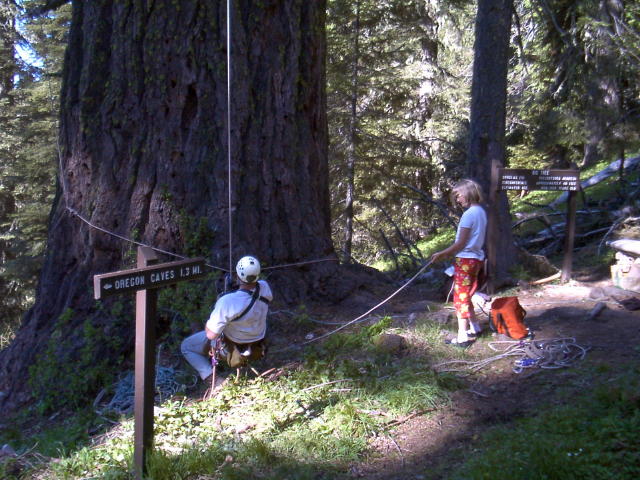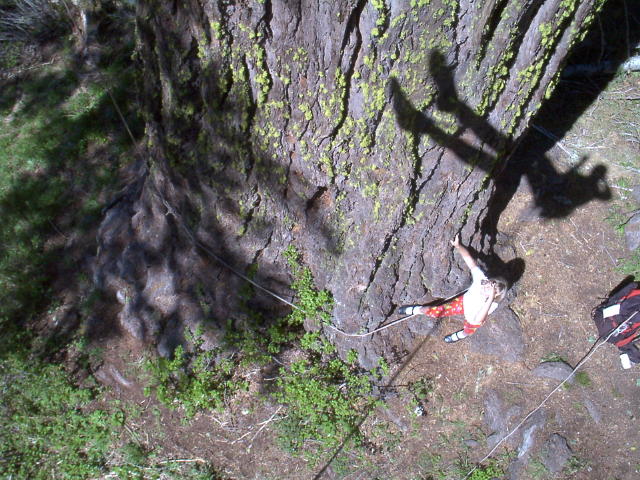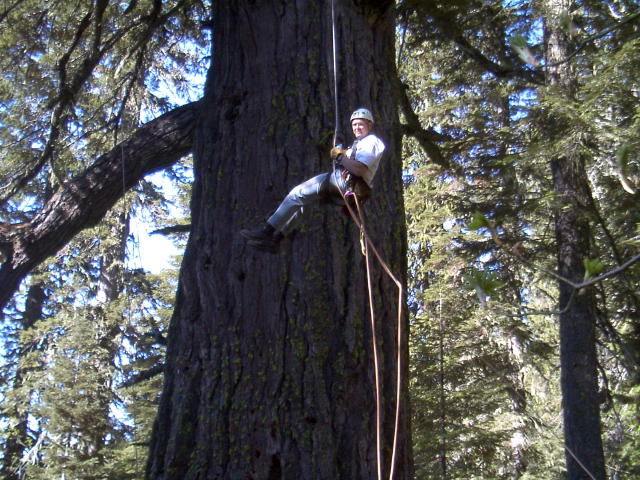OREGON CAVES FIR June 1st, 2002. This weekends climb in the Pacific Northwest went well. Jerry & I sucessfully made it up the Oregon Caves National Monument Douglas Fir. On belayis my 11 year old daughter, April. The Beranek CO2 line launcher neatly dropped our jug rope pilot lineover a 3 foot diameter limb at 100'. The widely spaced limbs provided a chance to use the throwline up in the tree for 4 different settings. Although the tree trunk is 12' thick, the top has blown out at 160'. It is possible that this fir has never been climbed before, making it a first ascent. The tree is up a VERY steep trail. A logging road a few hundred yards before the Monument entrance will allow driving part way up the hill. We had scoped it out years ago, so it was not an "on sight" climb, as the rock climbers regard a climb which is commenced immediately upon viewing the route for the first time. Does the future of tree climbing involve such splitting of hairs with the duality of aid/free climbing, route from base to summit variations, and protection-free 'bare' ticks?  Once at the top, Jerry & I discussed adding a couple of criteria to the difficulty rating system for tree climbing. Relying on massive, old growth deadwood as a lifeline anchor is possible with an assessment of the soundness of the wood. How is the assessment done? Bya quiring experience with breaking old growth wood. How do you break old growth wood (which is a LOT harder than young sapwood)? By falling trees, of course. This type of knowledge teems in a cauldron of experience seething away in the back of the woodsman's mind. Just a stroll down a trail under a multi-layer canopy in virgin timber can be a tremendous learning experience to someone attuned to the concentrated evidence of the process of breaking down large diameter trees into nutritious forest duff. With every step taken, there is dead & down woody material displayed in every stage of decomposition. 
Looking at a nurse log, imagine how old it was when it died. Imagine how long it stood before it fell. Imagine backthrough several tree lifespans and reconstruct which of the adjacent trees sprouted when. This stroll down the path is like interviewing your dead ancestors, and coming up with an accurate geneological family tree of that forest stand. Look at the position of the woodand the forces it took to bring it to the ground. The answers given by the rings of a tree do not lie. Another fact of life up in big trees is exposure to a big swing or leader fall. How 'bout loose slabs of barksloughing off when a rope runs under the edge? Tack these on to the 5.12+ list, right before TS (trainedsquirrel). Wear your hardhat, and carry your donor card. |
Home |